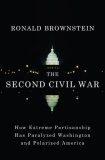Division of the U.S. didn’t occur overnight
During President George W. Bush’s first term, one of his senior political advisers summed up the prevailing philosophy at the White House like this: “This is not designed to be a 55 percent presidency,” he said. “This is designed to be a presidency that moves as much as possible of what we believe into law while holding 50 plus one of the country and the Congress.” Bold ideas that could mobilize his conservative Republican base were prized over efforts to convince independent voters in the center; sharp divisions over the administration’s policies were regarded as proof of Mr. Bush’s decisiveness and willingness to challenge conventional thinking.
 As the veteran political reporter Ronald Brownstein observes in his timely and compelling new book, this is very much how President Bush has governed: “In his congressional strategy he consistently demonstrated that he would rather pass legislation as close as possible to his preferences on a virtually party-line basis than make concessions to reduce political tensions or broaden his support among Democrats.” And in his dealings with both Congress and other nations before the invasion of Iraq, Mr. Brownstein goes on, Mr. Bush “sought not to construct a consensus for a common direction on Iraq, but rather to obtain acquiescence for the undeviating direction he had charted in his own mind.” [complete article]
As the veteran political reporter Ronald Brownstein observes in his timely and compelling new book, this is very much how President Bush has governed: “In his congressional strategy he consistently demonstrated that he would rather pass legislation as close as possible to his preferences on a virtually party-line basis than make concessions to reduce political tensions or broaden his support among Democrats.” And in his dealings with both Congress and other nations before the invasion of Iraq, Mr. Brownstein goes on, Mr. Bush “sought not to construct a consensus for a common direction on Iraq, but rather to obtain acquiescence for the undeviating direction he had charted in his own mind.” [complete article]

